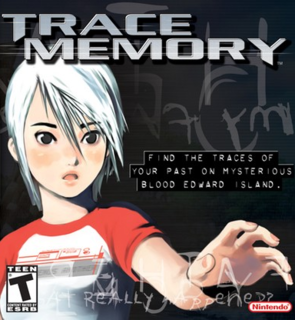Trace Memory is a great adventure game with a remarkable story that utilizes the different mechanics of the DS.
Trace Memory starts off with a girl named Ashley on board a boat as she makes her way for Blood Edward Island. The story is fleshed out through a series of memories foretold by Ashley herself, as well as other characters throughout the game. Basically, when Ashley was young her dad abandoned her to go work on a secret experiment entitled Trace. As an effect, Ashley is sent to live with her Aunt, while her dad set off to Blood Edward Island to work on his research. Ashley is now nearing her 14 birthday, and was asked by her father to come meet him at the island as his research is complete.
If things seem complicated at first, they are. The story needs some getting used to, and the dialogue seems unsettling at times, often requiring some characters to blast out total nonsense. But effectively, Trace Memory does a really good job in offering a solid back-story so that by the end of the game, you will feel inclined to know more about all of the characters.
As Ashley arrives on Edward Island with her Aunt, she soon realizes no one is around and her Aunt soon disappears trying to find Ashley’s father. Ashley takes it upon herself to find her Aunt and her father, and learn the secrets behind her past. You will control Ashley in a type of overhead view, watching her run around trying to find her father’s whereabouts. The bottom screen on the DS is dedicated to exploring, while the top screen does nothing more than show still pictures of the scenery from which you are near. Admittingly, it does tend to get old very fast, as you are constantly moving from place to place, and watching the top screen change pictures at random sometimes feels like the game is trying to give you a seizure. Although the entire game takes place on Edward Island, Ashley will spend most of her time in a giant mansion located on the back part of the island. Before Ashley makes her way inside the mansion however, she meets a ghost named D, who was awakened when Ashley knocked over his gravestone. Unable to recall his memories of whom he is or how he died, he quickly joins Ashley as she searches for her father. D really has no purpose in Trace Memory other to provide some insight and back-story for the Edwards family, for which he belongs. Throughout the game you will steadily figure out who D really is, and how he ties into the Edwards family timeline.
As Ashley is searching for her father, she realizes that the mansion itself is sort of like a giant puzzle, requiring her to go on miniature scavenger hunts in order to open the next room. What makes Trace Memory stand out from the other puzzle-solving games in the same genre is the cleverness and unique ways to use the DS to solve the mysteries. For example, there was a time when I had to use the stylus to turn a key into a hole, or actually close the DS while playing in order to copy something on the bottom screen. The spectacular uses of the DS never seized to amaze me, and you will soon realize how many different and clever ways the DS can be used. You will ultimately use your DS to blow, brush, poke, twist, and pull your way to the next clue. But while Ashley is searching to clues about her past, she soon finds out A LOT of info about the Edwards family, for it’s their house she is wandering around in. As you go room by room, learning new events that tie into the storyline, Ashley slowly starts to remember memories of her past that she once forgot. D too remembers things he hasn’t remembered in over 60 years, and the story blends together perfectly in such a well written script. However, most of the actual solving quests require constant backtracking. Such as finding a hammer in one room and not being able to pick it up, but than wandering about for 15 minutes and than realizing you need the hammer to break something and have to go all the way back to retrieve it. This mindless wandering feels a bit scathed compared to the overall higher quality of the adventure.
Although the story is very well written and is told with a great sense of conversation, at the end of every chapter players must do some sort of stupid memory test, in which Ashley recalls things she did just minutes ago and you have to correctly tap the correct answer. This is seen as nothing more than a lazy way of advancing through chapters, and it is really boring compared to the other aspects of the story.
All in all, Trace Memory is a great adventure game with a remarkable story that utilizes the different mechanics of the DS. While some may get bored by the overall nonsense of backtracking and puzzle solving, those of you who keep their heads in the game and get involved with the story will no doubt have a good time.

